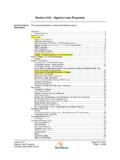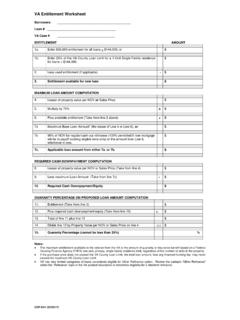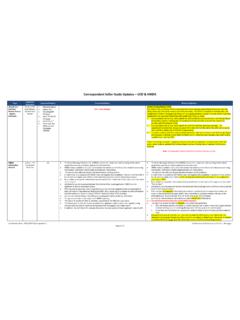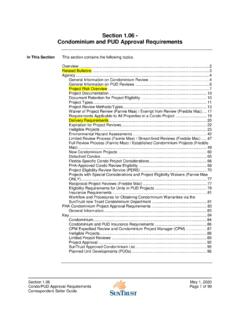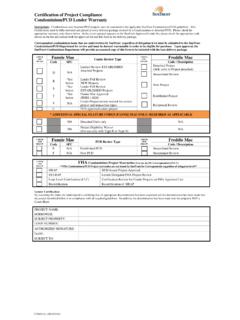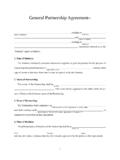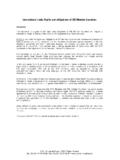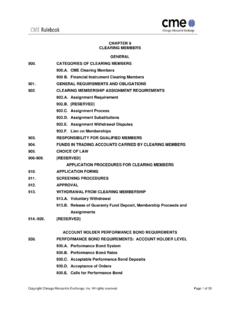Transcription of Agency Guideline Revisions - STMPartners
1 Agency Guideline Revisions Note: SunTrust Mortgage specific overlays are underlined. Last Revision Date: 03/03/2017 (Correspondent) Page 1 of 14 Topic Impacted Document Impacted Products Current guidelines Revised guidelines Effective Immediately for NEW AND EXISTING Loan Applications ON OR After March 3, 2017 Lease Payments Correspondent Section Agency Loan Programs- Guideline Standard Agency (non-AUS, DU & LPA) Agency Plus (DU & LPA) DU Refi Plus Texas Cash-Out Refi (DU) Liabilities and Qualifying Ratios / Lease Payments Non-AUS Lease payments are included in the debt ratio, regardless of remaining payments. Fannie Mae DU Non-AUS guidelines apply. Freddie Mac LP Non-AUS guidelines apply. Liabilities and Qualifying Ratios / Qualifying Ratios Non-AUS DTI Ratios The DTI ratio consists of two components: total monthly obligations, which includes the qualifying payment for the subject mortgage loan and other long-term and significant short-term monthly debts; and total monthly income of all borrowers, to the extent the income is used to qualify for the mortgage.
2 For non-AUS loans, the overall maximum debt-to-income (DTI) ratio may not exceed 45%, except as outlined below: When one or more borrowers on the loan does not have a credit score and is relying on non-traditional credit to qualify, the maximum DTI ratio is 36%. Using only the income of the occupying borrower(s) to calculate the DTI ratio, the maximum allowable DTI ratio is 43%. Note: This maximum DTI applies even if the combined qualifying ratios for the borrower and the guarantor, co-signer, or non-occupant borrower are well below 45%. See the non-traditional credit guidance shown above ( , maximum 36% DTI) that applies when the transaction includes a non-occupant borrower who does not have a credit score Liabilities and Qualifying Ratios / Lease Payments Non-AUS Lease payments must be considered as recurring monthly debt obligations regardless of the number of months remaining on the lease.
3 This is because the expiration of a lease agreement for rental housing or an automobile typically leads to either a new lease agreement, the buyout of the existing lease, or the purchase of a new vehicle or house. Reference: See the Properties with Solar Panels subtopic previously outlined in this document for an exception to the above guidance for payments for solar panels subject to a lease agreement, power purchase agreement (PPA) or similar type of agreement that meets Guideline requirements. Fannie Mae DU Follow DU requirements, which are the same as non-AUS guidelines . Freddie Mac LPA Follow LPA requirements, which are as follows: Monthly lease payments, regardless of the number of payments remaining, with the exception of payments for solar panels subject to a lease agreement, power purchase agreement (PPA) or similar type of agreement that meets Guideline requirements, must be included in the monthly debt payment-to-income ratio.
4 Reference: See the Properties with Solar Panels subtopic previously outlined in this document for additional guidance. Liabilities and Qualifying Ratios / Qualifying Ratios Non-AUS General Information on Liabilities The lender s risk analysis must include all liabilities affecting income or assets that will affect the borrower s ability to fulfill the mortgage payment obligation. A borrower s liabilities include the following: housing expense on the borrower s primary residence, all revolving charge accounts, installment loan debts with a remaining payment term greater than 10 months, lease payments, real estate loans, HELOCs, alimony and child support, maintenance payments, and all other debts of a recurring nature. For each liability, the lender must determine the unpaid balance, the terms of repayment, and the borrower s payment history, and verify any other liability that is not shown on a credit report by obtaining documentation from the borrower or creditor.
5 See the Undisclosed Debts subtopic subsequently presented in this topic for additional guidance. Agency Guideline Revisions Note: SunTrust Mortgage specific overlays are underlined. Last Revision Date: 03/03/2017 (Correspondent) Page 2 of 14 Topic Impacted Document Impacted Products Current guidelines Revised guidelines Effective Immediately for NEW AND EXISTING Loan Applications ON OR After March 3, 2017 Monthly Obligations Not Included in Liabilities Some obligations, often identified on a borrower s paystub, are not considered a liability and will not be included as a debt or deducted from the borrower s gross income when calculating the borrower s debt-to-income ratio. These obligations include items such as federal, state, and local taxes; Federal Insurance Contributions Act (FICA) or other retirement contributions, such as 401(k) accounts (including repayment of debt secured by these funds); commuting costs; union dues; and voluntary deductions.
6 Calculating Total Monthly Obligation The total monthly obligation is the sum of the following: the monthly housing expense of the borrower's primary residence (or the qualifying payment amount if the subject mortgage loan is secured by the borrower's primary residence; the qualifying payment amount if the subject mortgage loan is secured by a second home or investment property; monthly payments on installment debts and other mortgage debts that extend beyond ten months; monthly payments on installment debts and other mortgage debts that extend ten months or less if the payments significantly affect the borrower s ability to meet credit obligations; monthly payments on revolving debts; monthly payments on lease agreements, regardless of the expiration date of the lease; monthly alimony, child support, or maintenance payments that extend beyond ten months; monthly payments for other recurring monthly obligations; and any net loss from a rental property.)
7 Payoff or Paydown of Debt for Qualification Payoff or paydown of debt solely to qualify must be carefully evaluated and considered in the overall loan analysis. The borrower s history of credit use should be a factor in determining whether the appropriate approach is to include or exclude debt for qualification. Generally: Installment loans that are being paid off or paid down to 10 or fewer remaining monthly payments do not need to be included in the borrower s long-term debt. If a revolving account balance is to be paid off at or prior to closing, a monthly payment on the current outstanding balance does not need to be included in the borrower's long-term debt, , not included in the debt-to-income (DTI) ratio. Such accounts do not need to be closed as a condition of excluding the payment from the DTI ratio. DTI Ratio Tolerance and Re-Underwriting Criteria Fannie Mae expects lenders to have in place processes to facilitate borrower disclosure of changes in financial circumstances throughout the origination process to increase the likelihood of discovering material undisclosed debts.
8 See the Undisclosed Debts subtopic subsequently presented in this topic for additional information. As a result of the lender's normal processes and controls, the lender may need to re-underwrite the loan after initial underwriting. If the borrower discloses or the lender discovers additional debt(s) or reduced income after the underwriting decision was made up to and concurrent with loan closing, the loan must be re-underwritten if the new information causes the DTI ratio: to exceed 45%; or Monthly Obligations Not Included in Liabilities Some obligations, often identified on a borrower s paystub, are not considered a liability and will not be included as a debt or deducted from the borrower s gross income when calculating the borrower s debt-to-income ratio. These obligations include items such as: federal, state, and local taxes; Federal Insurance Contributions Act (FICA) or other retirement contributions, such as 401(k) accounts (including repayment of debt secured by these funds); commuting costs; union dues; and voluntary deductions.
9 DTI Ratios The DTI ratio consists of two components: total monthly obligations, which includes the qualifying payment for the subject mortgage loan and other long-term and significant short-term monthly debts; and total monthly income of all borrowers, to the extent the income is used to qualify for the mortgage. For non-AUS loans, the overall maximum debt-to-income (DTI) ratio may not exceed 45%, except as outlined below: When one or more borrowers on the loan does not have a credit score and is relying on non-traditional credit to qualify, the maximum DTI ratio is 36%. Using only the income of the occupying borrower(s) to calculate the DTI ratio, the maximum allowable DTI ratio is 43%. Note: This maximum DTI applies even if the combined qualifying ratios for the borrower and the guarantor, co-signer, or non-occupant borrower are well below 45%.
10 See the non-traditional credit guidance shown above ( , maximum 36% DTI) that applies when the transaction includes a non-occupant borrower who does not have a credit score Calculating Total Monthly Obligations The total monthly obligation is the sum of the following: the monthly housing expense of the borrower's primary residence (or the qualifying payment amount if the subject mortgage loan is secured by the borrower's primary residence); the qualifying payment amount if the subject mortgage loan is secured by a second home or investment property; monthly payments on installment debts and other mortgage debts that extend beyond ten months; monthly payments on installment debts and other mortgage debts that extend ten months or less if the payments significantly affect the borrower s ability to meet credit obligations; monthly payments on revolving debts; monthly payments on lease agreements, regardless of the expiration date of the lease; monthly alimony, child support, or maintenance payments that extend beyond ten months; monthly payments for other recurring monthly obligations; and any net loss from a rental property.
